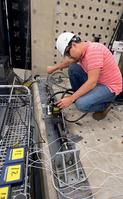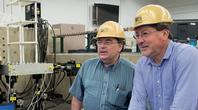Purdue leads multi-hazard research with $4.1 million NSF Award


In 2015, thunderstorm winds and tornadoes caused 77 deaths and nearly half a billion dollars in damage in the U.S. In 1994, the Northridge earthquake in Southern California caused 57 deaths and about $30 billion worth of damage.
In the face of such natural hazards — and to mitigate their devastation — research engineers and scientists investigate methods for rendering our civil infrastructure safer and making our communities more resilient.
To this end, the National Science Foundation recently named Purdue University as the recipient of the Network Coordination Office (NCO) for its National Hazards Engineering Research Infrastructure (NHERI). The NCO, a $4.1 million, five-year award, will lead the $65 million NHERI network in its goal to minimize damage to our nation’s physical civil infrastructure.
Purdue Expertise in Hazard Engineering
Julio Ramirez, professor of civil engineering at Purdue, was tapped to direct the NCO. From 2009 through 2014, Ramirez served as director for NSF’s George E. Brown Jr. Network for Earthquake Engineering Simulation (NEES), a $105 million grant aimed at mitigating earthquake damage.
By contrast, the new NSF NHERI grant is multi-hazard, combining investigations from the earthquake, wind and coastal engineering, and social sciences communities.
Ramirez says that Purdue's success managing the NEES grant was a key factor in winning the NCO award for NHERI. "Purdue was viewed as the most suitable institution to lead the community, coordinate the large investment of the NSF and to conduct education and community outreach activities of this research infrastructure," he says.
Along with the NCO, the NHERI network consists of eight experimental facilities, a cyberinfrastructure platform for collaboration and a simulation center — components located at universities around the country.
“The NHERI NCO will lead the engineering community into adopting multi-hazard approaches,” Ramirez says. “With NEES, our focus was earthquakes and associated damage. With NHERI, we focus on windstorms, too. Things that we’ve learned in earthquake engineering can be applied to engineering for windstorms and vice versa.”
“Most importantly,” Ramirez says, “We want engineers and scientists to become multihazard in their thinking, to approach resilience of communities as a whole.”
Other Purdue researchers on the NCO team are Antonio Bobet, professor of civil engineering, who brings extensive geotechnical engineering expertise, and David R. Johnson, an assistant professor with joint appointments in political science and industrial engineering. Johnson will bring experience in interdisciplinary methods and cutting-edge scientific research to inform policymaking and social science research.
Co-principal investigators on the NCO team are JoAnn Browning, dean of the College of Engineering at the University of Texas at San Antonio; Billy L. Edge, professor of civil, construction and environmental engineering at North Carolina State University and head of coastal processes and engineering at the Coastal Studies Institute at the University of North Carolina; and Delong Zuo, associate professor of civil, environmental and construction engineering at Texas Tech University.
Multi-Hazard Research Plan
The first step for the Purdue-based NCO is to lead the community into developing NHERI’s formal research agenda, a five-year science plan. “It’s an articulation of the priorities, grand challenges, and the key problems we’re going to solve,” Ramirez says. “This science plan, developed by the research community, will in turn become the research agenda that NSF and other agencies will fund to make our infrastructure safer against windstorms and earthquakes.”
“One of the key goals is to bring together those two very different research communities, people formerly working on the separate paths of earthquake and wind engineering,” Ramirez says.
NCO Leadership
The NCO will serve as the focal point and driving force of a multi-hazards research community focused on mitigating the impact of future earthquakes and windstorms and related hazards such as tsunamis and storm surge on our nation’s communities. The NCO team will work with NHERI’s experimental facilities to ensure the efficient testing of new technologies within a totally safe environment, to centrally coordinate testing schedules, and to facilitate shared technical knowledge and best practices. Other NCO tasks include leading education and outreach and developing strategic partnerships around the world to form a cohesive, global natural-hazards engineering research infrastructure.
Ramirez encourages fellow researchers to get involved. “NHERI is for anyone interested in improving the resilience of our communities, of our buildings, highways and bridges against earthquakes and windstorms,” he says. “This NHERI infrastructure puts all sorts of tools at researchers’ disposal: cyber, physical and educational. Get involved. Use it. Take advantage of it. Make your communities safer.”
Related Link: http://www.purdue.edu/newsroom/releases/2016/Q4/purdue-to-lead-multihazard-research-with-4.1-million-nsf-award.html
